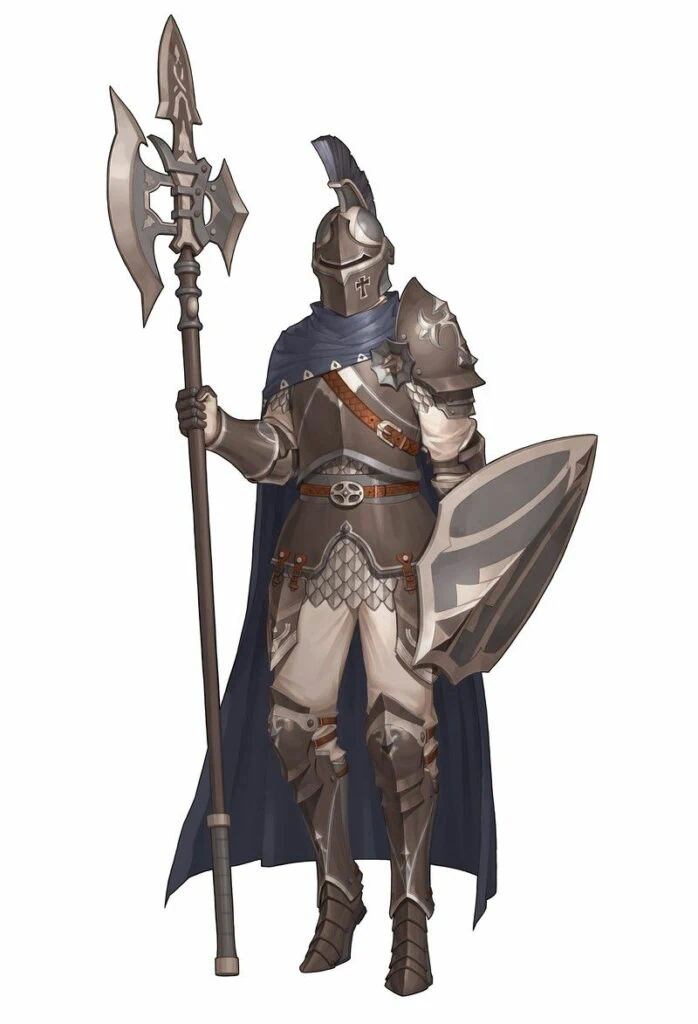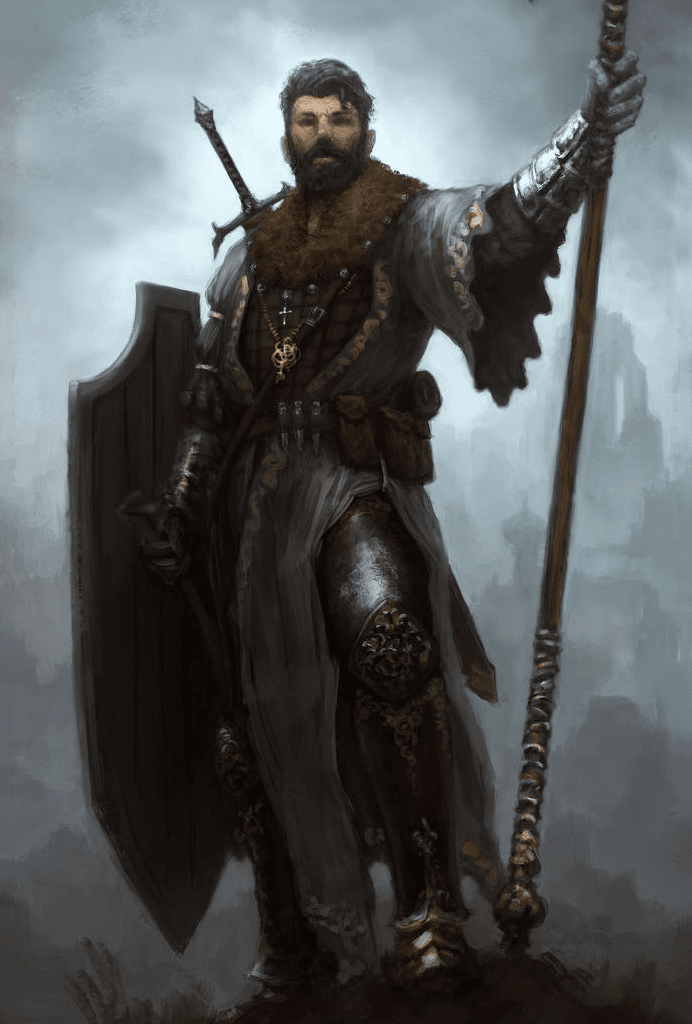Ahead of you stands the exit of the dungeon. Things got out of hand pretty quickly. Two failed stealth checks and a bad deception check made everything complicated. Who would have thought that the cultist underground castle was so crowded? Your party started to run away three minutes ago, and you’re just reaching your goal: escape.
Wait! There is a big problem ahead. When the alarm was set, the outside doors closed. The rogue needs a minute to unlock the mechanism. The bard and the wizard are battling the few foes inside the room. You are the one required to stop the enemies from entering the hall. Easy for a battle master with his trusty halberd.
You stand your ground just under the door’s frame and point towards the narrow hallway where the hoard of cultists are coming, a dagger in hand. There are around thirty brown capes trying to pass like a swarm of cockroaches through a sinking filter.
They don’t stand a chance. One by one, they got stuck in their tracks, unable to pass through your barrage of fighter attacks, maneuvers, and reactions. You leave a dozen corpses at the entrance as you join your party outside the building.
Welcome to Halberd 5e Guide on the “twin pole-arms”:
Masters of the Battlefield
You get something amazing whenever you take the spear, the most reliable weapon in history, as a base for a weapon. It is easy to make and wield, just deadly enough to any enemy in almost every circumstance, and simple enough to add things on top without a problem.
For those reasons, the spear was one of the first weapons made by almost every culture in the prehistorical era.
What do all these mean for the halberd and the glaive? Well, they are both enhanced versions of the spear. By adding length to the shaft and utility to the top, these weapons became prominent in the late Middle Ages until today.
Both weapons share similar characteristics that we’ll discuss further, but the main difference is the weapon’s end. The glaive presents a single-edged blade, sometimes with a spike on the back end, while the halberd has an ax head on the front side and a hook on the back, both tilted towards the wielder, and lastly, a long spike on the tip.
Read also: Comprehensive Guide to DnD Weapons.
Breaking Down the Rules

On page 149 of the Player’s Handbook is the weapons table of DND 5e. We can see that the Glaive and the Halberd have the same statistics, price, and weight. For that reason, I’ll be referring to them as Halberds most of the time, but remember that both terms are mechanically interchangeable.
Both weapons are Martial Melee Weapons with 1d10 slashing damage and the Heavy, Reach, and Two-handed properties. Both pole-arms are worth 20 GP and weigh 6 lb.
It’s good to point out that Pikes also have the exact statistics except for the damage type. With these in mind, every build and rule that we’ll discuss with these two weapons applies to the Pike except for some feats and monsters’ specific resistances or immunities.
Statistics
Before we continue, let’s stop and see what the weapons have to offer by themselves:
- Martial weapons: Weapons in this category are not meant to be wielded by just anyone. They are appropriate for trained people. Weapons in this category are meant to be stronger than the Simple ones because of the training barrier.
- Melee Range: By default, this is 5 feet, or, in other words, the character’s perimeter. It’s evident at first glance, but it’s important to remember that the weapon is melee when we discuss its reach. Even if you attack farther than 5 feet, the attack is still considered melee regarding other rules.
- 1d10 damage: One of the game’s most damaging die for weapons. The average damage would be 5,5 and the max damage 10, plus STR modifier. The only melee weapons that beat them in damage output would be the Greataxe, Greatsword, Lance, and Maul.
- Cost and weight: Lastly, they’re worth 20 GP, which puts them in the middle of the price spectrum for weapons. Funny because, in reality, the halberd was very expensive to make because of the complexity of its design.
They also weigh six lb. which makes them very light for their size, which doesn’t have many mechanical implications unless your table uses the encumbrance rules.
Properties
- Heavy: It’s one of those moments when the game mechanics try to impart some realism to the game. Nothing would make one of the small races overpowered for using a glaive, but it is odd to see a gnome using a weapon three times larger than themselves.
The hulking barbarian halfling could lift an elephant but not wield halberds. I’d rule you can break these rules if you have a good reason. If you don’t, there is always the possibility of a magical halberd so light that a tiny pixie can use it properly.
- Two-handed: This is another mechanical limitation. Using both hands for a weapon has realism and a power-balance angle. For realism, these weapons are meant to be used with both hands to be valid.
No human could weild two halberds. For balance, having to use two hands for a weapon prevents the character from having a hand free for spells or off-hand attacks.
- Reach: This is the real game-changer of these weapons. It maybe seems minor, but it’s not. Having just five extra feet of range, but maintaining its status as a melee weapon, triggers a lot of interesting interactions with other game rules.
The main benefit of reach is that many creatures only have melee attacks. Five feet melee attacks. This is awesome if you also consider that most humanoids have only 30 feet of movement.
You can attack a creature from reach, run away 30 feet without triggering an opportunity attack, then wait. The enemy comes forward but has to use their action for dashing. This essentially gives you a free turn against these types of foes.
Who Can Wield Such Weapons
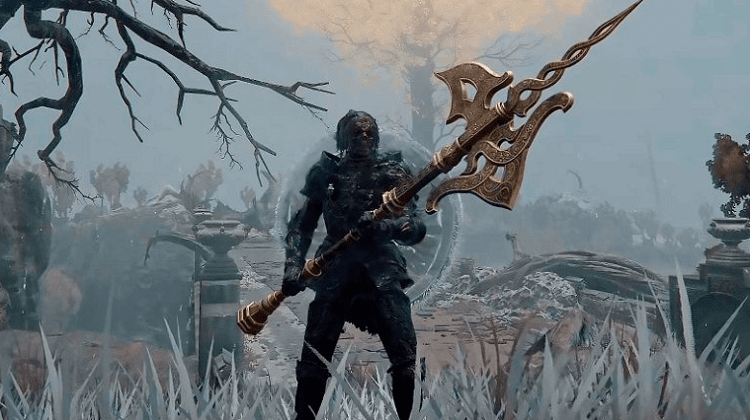
As I said, Martial Weapons need thorough training to be usable. Not every character has proficiency in them, meaning they don’t add their proficiency modifier to the attack or any other interaction that needs you to be proficient in a weapon.
The classes that can take advantage of their training are Barbarians, Fighters, Paladins, and Rangers.
Furthermore, specific subclasses give proficiency in Martial Weapons such as Hexblade for Warlocks; War, Twilight, and Tempest Domain for Clerics; Battle Smiths for Artificers; etc.
Also, you can gain proficiency with some races, such as Hobgoblins, or you can swap your proficiency in a weapon using the Proficiency Swap Table from Tasha’s. With that said, anyone can grab proficiency in a weapon at the fourth level with the Fighting Initiate or Weapon Master feat.
Although any medium size character could use the halberds with proficiency just by grabbing a feat at the fourth level, not every character is suited for the play style these weapons bring to the table.
A sorcerer is far less likely to be a halberdier than a Barbarian. A Human has better things to offer to the build than a High-Elf. What I’ll give you now are not the only Races and Classes you can use for a halberdier, but they are mechanically the best.
Races
One disclaimer: I’ll use the rules from Tasha’s Cauldron of Everything for changing stats bonuses and the variants in the Monsters of the Multiverse book. With that said, almost every medium race is helpful, but some have a bit more punch.
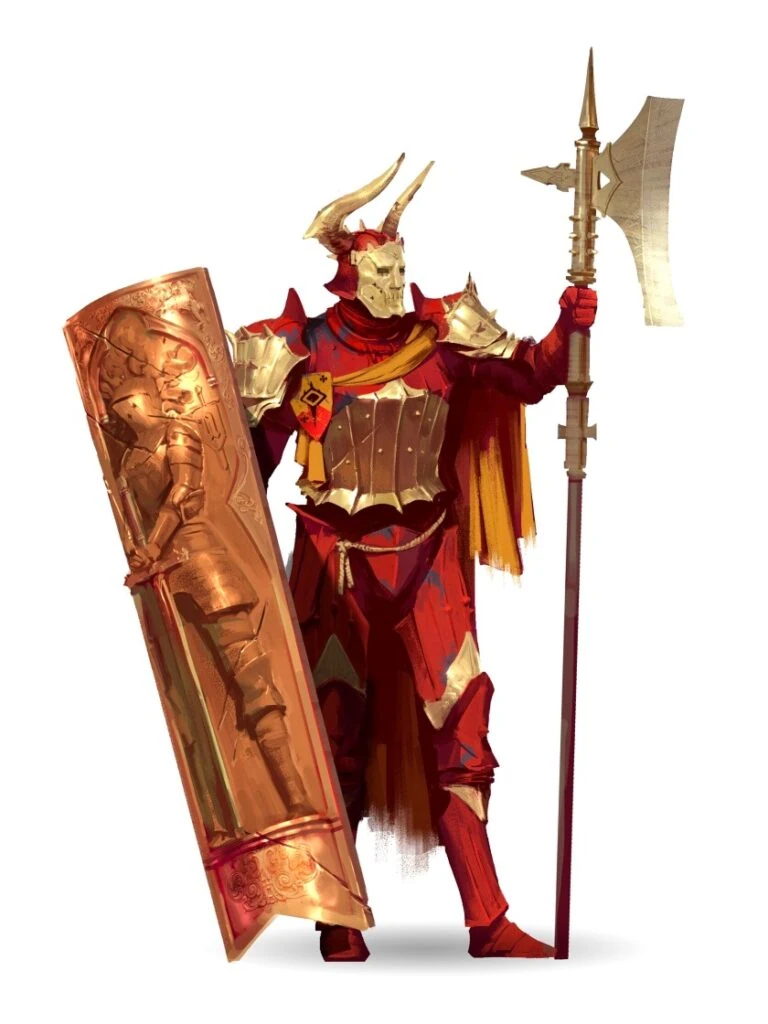
Variant Human / Custom Lineage
An extra feat at the first level is suitable for almost every character. This is probably why Variant Human was the most used race until Custom Lineage rocked the table. They are both great races because of the feat they grant. You’ll see later why.
Half-orc
When you think about a pole-arm wielder, you’re thinking of a front-liner: a character able to make lots of attacks and withstand the enemies’ pressure. Half-orcs have improved critics and darkvision. Thanks to Relentless Endurance, if you’re also a Zealot or a Totem of the Bear Barbarian, you can’t die! Orcs are similar but without the better critics.
Goliath
Similar to Half-orcs, these giant humanoids are great with these weapons for their strength bonus (If applicable) and stone endurance. They also look intimidating when you picture them out.
Aasimar
Unlike Owlin or Aaracokra, Aasimar’s flight can be used even with heavy armor, which is fantastic for a Strength-based build like those with halberds. I love the image of a flying paladin throwing down smites with a glaive, like a vengeful angel. This flight is temporary, but they have some resistances to balance it out.
Bugbear
If a 10-foot reach is incredible, Bugbears add another 5 ft to the attack. This is great if you think your opportunity attacks now cover a 15 ft radius around you. On top of that, you have extra damage against surprised foes, which can make a big difference, especially on early levels.
Harengon

Little rabbits with pole-arms? They don’t seem to pair well until you consider that the Rabbit Hop ability of Harengon doesn’t provoke opportunity attacks.
If the enemy manages to close distance with you, you can get away very quickly and attack them again from a distance. The bonus to initiative rolls is also perfect for front-liners because they can get to the right place to protect their allies earlier.
Shifter
These bestial humanoids have extra hitpoints, making them sturdier during combat. On top of that, they get abilities that pair well with a halberd. The Beasthide and the Swiftstride are great options to give you some battle endurance or utility.
Leonin
From Theros, these lion-like creatures are exceptional for any melee combatant. They start with a 35 ft movement, which is excellent with pole-arms. However, they get better when you consider the Daunting Roar ability because they can lock a creature 10 ft away from them in fear, ready to strike with an attack of opportunity if they run away.
Classes and Subclasses
The game has a long list of subclasses, and everyone has much to offer. Therefore, I’ll discuss the five most potent classes and their best subclasses.
Fighter
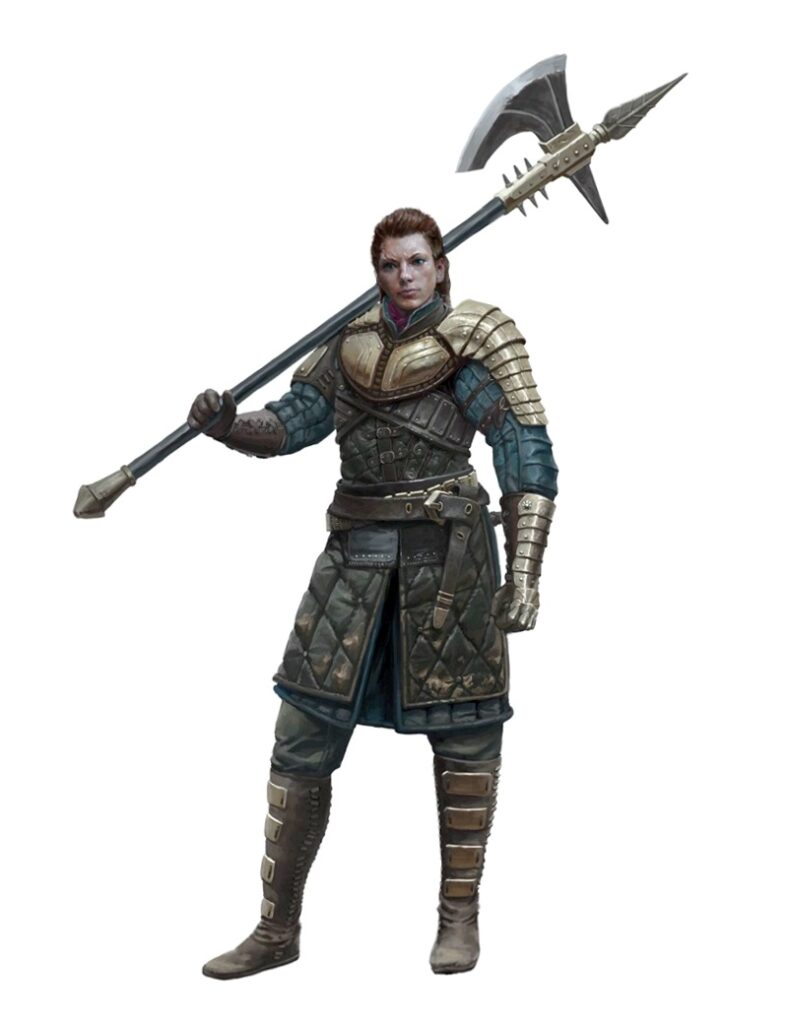
All subclasses of fighters are fantastic with halberds, except Arcane Archers. Fighters are just built to make massive amounts of damage with big weapons.
The extra attacks and ASI (Ability Score Improvement) or feats, Action Surges, Fighting Style, etc. You have a complete package of front-line solid and beat-down potential with fighters.
Echo Knight
I think the Echo Knight is the best Halberdier of the game. They have an excellent capability for maneuvering around the battlefield in unique ways. They have a second body that can benefit from the extra reach of the halberds and little teleportations that let them position at the right angle to have better turns.
One thing to keep in mind is that, unless the DM allows it, the attack of opportunity of the Echo doesn’t benefit from the extra reach and feats that apply to halberds.
Barbarians
The hulking muscle of the party is an excellent choice for a pole-master. The Barbarians have extra and reckless attacks, making all with advantage, including the Pole-arm master’s bonus action attack. Furthermore, they get extra movement, health, resistance, better critics, and most of all, RAGE!
Totem
In general terms, the Totem Barbarian is the strongest. Just the bear totem at level three grants resistances to all damage making your barbarian virtually immortal.
Besides that, the eagle grants extra movement, and the wolf gives you some support options. By far the sturdiest of all the Halberdiers you can have in the game.
Paladins
Divine smite, Two-weapon fighting, support abilities and spells, heavy armor. Paladins have all the things a strength base character wants.
They are a versatile class with the most significant damage output. Besides, the Summon Steed spell screams of pole-arm. Knighthood is a big part of halberds, and Paladins are the quintessential Knights:
Conquest
Even though the Vengeance Paladin is more potent in most cases, the combination of Aura of Conquest with Conquering Presence locks a creature at 10 feet of the Paladin, making the foe an easy target for all the attacks with the reach of the halberds.
Furthermore, spells like Armor of Agathys, Hold Person, and Spiritual Weapon are great for standing your ground and controlling the battlefield as you see fit.
Artificer
The only artificer worth is the Battle Smith because the other two lack Martial Weapon Proficiency, and their abilities often clash with martial weapons.
Battlesmith
What they lack on AC because they don’t have heavy armor; they have it on a pet. Battlesmiths are great tanks without a shield because of their Steel Defender and its reaction.
On top of that, they attack with their intelligence, have an extra attack, great offensive spells, and other ways of getting additional damage. Combining the steel defender with the halberds’ reach allows this subclass to stand away from the enemy without leaving their allies.
Cleric
The holy ambassadors of gods usually are seen as simple healers and weaklings standing in the background to avoid damage. However, clerics in DND can take many forms, many of which are exceptional for close combat.
The subclasses most adept for a pole-arm style of play are the ones with Heavy Armor and Martial Weapon Proficiency, as they are the ones who tend to have things bolstering melee combat:
Tempest
Undoubtedly, the strongest pole-arm Cleric is the Tempest Domain. At the 6th level, they gain the ability to push a creature 10 feet away when they make thunder or lightning damage. This pairs wonderfully with their 1st-level Wrath of the Storm and 8th-level Divine Strike.
Pairing these abilities with a halberd makes your reach a wonder because you can be pushing creatures around without ever entering their melee. Furthermore, if they get past your reach, you can still push them away quickly, keeping your distance and doing tons of damage with spells.
Feats

Feats are optional rules in DND. However, few tables don’t use them, for good reasons. They add a lot of personalization to the game, which in turn, makes every table unique. But feats are more than simply flavor.
They add power to a well-rounded character. Regarding halberds and glaives, a few feats stand out from the rest and bring a solid weapon to an outright broken build. These are discussed extensively on the internet so I won’t go too deep into them.
Sentinel
This feat brings the reach of the halberds to a new level. The simple ability to reduce enemies’ speed to 0 when hit by an attack is enough to make your character a pain in the ass for the DM.
With a reach of 10 feet, this attack locks an enemy with only melee attacks away from you and your allies. This combination destroys some creatures. For example, flying monsters without the ability to hover would fall to the ground prone. All of this gets better when you pair it with the following feat.
Polearm Master
Now, you can make that same attack of opportunity against a creature that ENTERS your reach. If they get close, they get hit, and their speed is 0; if they try to run away, the same happens.
As long as you don’t miss the attack, enemies are screwed! On top of this, you get an extra bonus action attack that can make the difference with time. This feat can be overlooked a bit if you take the Battlemaster’s Brace maneuver.
Slasher
Once more, a feat that allows you to hinder the enemies’ movement while also improving your critics. This feat allows you to control the battlefield even more, as you can make the enemies even harder to get past you.
Great Weapon Master
After you’ve locked your enemies down, it is time to beat them to death. If you are confident you’ll hit your target, you can give yourself an extra +10 damage on every hit. I don’t need to explain how powerful this is.
Furthermore, when you score a critical hit or you kill an enemy, you can make an extra attack on another enemy.
Mobile
As we’ve seen, extra movement is essential for a pole-arm combatant. Mobile is a way of getting maneuverability for a melee build, making you run faster and provoke fewer opportunity attacks.
Inspiration for Halberds and Glaives
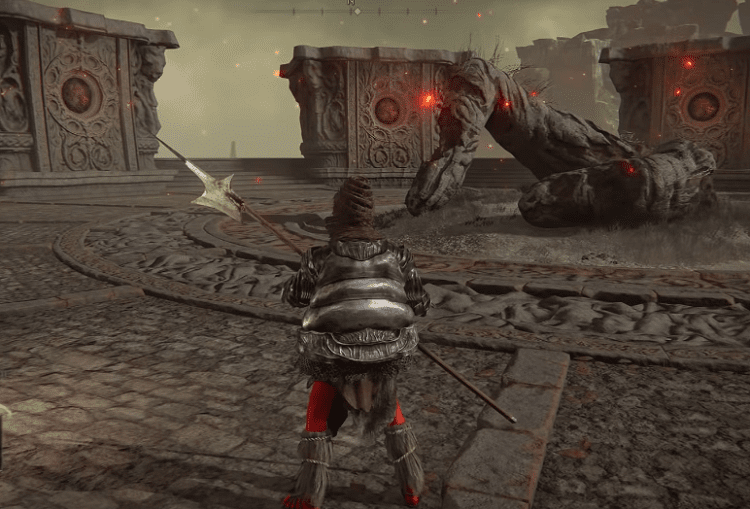
We’ve seen all the possibilities the game offers in build optimization, and it is up to you which combination you choose based on the character you’ve envisioned.
With that said, I’d like to give you some ideas based on history and my personal experience on how to make the best out of your weapon choice. In other words, I’d like to give you some tips to augment your roleplay.
In DND, the roleplay aspect of the game is mainly given by your choices of Class and Race, but most importantly, your Background, Bonds, Ideals, and Flaws. When we think of our character’s personality, their choice of weapon can tell us many things about them. You see, weapons are more than tools for murder.
They can be artistic in their looks and the way you use them. Furthermore, they can have personal connections with your character. Whether that connection is about inheritance, personal liking, a mentor, or trauma, you can draw from that to fuel your roleplay.
Maybe you never leave your halberd on the floor, but rather stick it on the ground so the banner of your country billows with pride wherever you go. I had a player once whose sword would try to possess him every day, and it was a gift from his father.
History and Mythology
Halberds and glaives have been a vast improvement in weapon history. They were mainly used against cavalry and plate armor. The lateral spike of both weapons was used to pull enemies out of their mounts and leave them prone on the floor, ready to be stabbed to death.
These weapons were so predominant in late medieval history that entire sections of armies were employed as a countermeasure for enemy cavalry. Thus, cavalry squads began to lower in number (this is an oversimplification, but you get the point).
With the passing of years and the introduction of fire guns in history, slowly but steadily, pole-arms began to lose their spot on the battlefield. They remained as ceremonial weapons, specially halberds.
Halberds were prevalent weapons for generals and served as a means of marking rank and wealth. Glaives (especially guisarmes), on the other hand, were cheaper to make, and therefore, they were more akin to the ordinary foot soldier.
Nowadays, very few people have access to medieval weapons, especially pole-arms. The most notable use of halberds today is the Swiss Guard in Vatican City, who are trained in using the weapon as a traditional means of defense.
Lastly, there’s a proposition that I’d like to make about glaives. The glaive is a weapon that is typically mistaken for many other weapons. This is such that glaive has no real distinction with the halberd in the game, which bugs me.
For that, I’d like to propose that whenever we talk about the glaive, we talk about the Japanese Naginata. This simple change of view opens a window into a different culture and, in turn, enriches the game experience.
Naginata was a pole-arm used by samurais in many periods of Japanese history. The weapon was a Glaive without the lateral spike and a longer edge. This pole-arm was very popular amongst samurai’s wives.
With time, this weapon became an obligatory self-defense measure for women in the country. Nowadays, it’s used as a sporting tool in martial arts.
I’d like to propose a little homebrew that halberds become a 1d10 piercing weapon while naginata (glaives) stay as a 1d10 slashing weapon. With this change, we could make these two more unique.
Fantasy and the World of DND

Even though pole-arm were so predominant in history, they are a bit underappreciated in fantasy. This is probably because these weapons were introduced very late in medieval history, making them non-existent in antiquity, the age from which most myths come.
Nonetheless, there are a few notable examples of weapons to draw inspiration from in the Forgotten Realms.
- Fayr’ Halberd: Bedwyn Fayr used his magical halberd in warfare against foes, striking from a distance while his shorter companions served as a first barrier for the enemies.
- Ravager: This was a notable halberd used by Imix, the Fire Prince of Elemental Evil. The weapon continuously dripped blood out of its blade.
- Wave: This halberd was made by cultists of an oceanic God known as Umberlee and could drain people’s water out of their bodies.
- In general, halberds were used as guard weapons in many settlements worldwide, such as Shadowdale or Sembia.
- Dauphal: This loxo (a creature half human, half elephant) was the owner of a flaming glaive that he wielded with great skill, even with his bulky size.
- Heart-cleaver: One of the most powerful beings of DND is the demon lord Baphomet. He is a bloodthirsty minotaur-like creature that wields a colossal glaive against his foes.
- Syr’daun Hunzrin: This human left the comfort of his home and wanted to prove his martial capabilities worldwide. He was a former farmer with great skill with glaives.
- Havilar: A Tieflin Warrior with a glaive called “Devil Slayer” had a tragic past from a village where she was expelled along with her sister.
- In the world of DND, there is also the usual Japanese reference. In this case, the Naginata was used by Samurais, Geishas, and Sohei warriors. Hobgoblins and ogre magi were also known to use glaives and naginatas.
FAQs
Question: Is there any Difference Between a Halberd and a Glaive?
Answer: No. Mechanically speaking, they are the same weapon. However, halberds and glaives are used somewhat differently in real life.
Halberds are used primarily as spears with the added benefit of having a side augment that grants many advantages against cavalry. Glaives, however, were used like greatswords with the added benefit of having extra reach and weighing less.
QUESTION: CAN I WIELD TWO HALBERDS OR GLAIVES IN DND 5E?
ANSWER: No, you can’t. For now, no mechanic allows players to dual-wield two-handed weapons. Anything that would allow that is homebrew.
QUESTION: CAN I USE MY DEXTERITY WHEN ATTACKING WITH A HALBERD OR A GLAIVE?
ANSWER: No, any melee attack made by a creature is made with strength, which includes halberds and glaives. Nonetheless, specific rules overwrite general ones. In that respect, a few abilities like the hex warrior hexblade feature or the battle ready battle smith feature allow you to use a different modifier for attack and damage rolls.
With that said, no ability gives you the option to use dexterity with a melee weapon without the finesse property. The only thing that could give you the ability to use these weapons with dexterity would be homebrew.
Worthy Weapons
To sum it all up, halberds and glaives are awesome weapons in real life and fantasy. They are excellent battlefield and war tools and unique adventurer’s choice.
I like how the developers of the game made these weapons as strong as they are because, in that way, they contribute to the proliferation of these weapons in tabletop and fantasy.
There are a lot of weapons, but the Pole-arms in general and this two, in particular, deserve a better place in fantasy. So please do me a favor and create an elegant glaivier or a terrifying halberdier and make these weapons a little more mainstream. Good luck fighting!
- Shadow Blade 5e Guide: The Edgy Sword - October 31, 2022
- Aid 5e Guide: Free Points! - October 1, 2022
- Flaming Sphere 5e Guide: Running Orb of Fiery Chaos: - October 1, 2022


